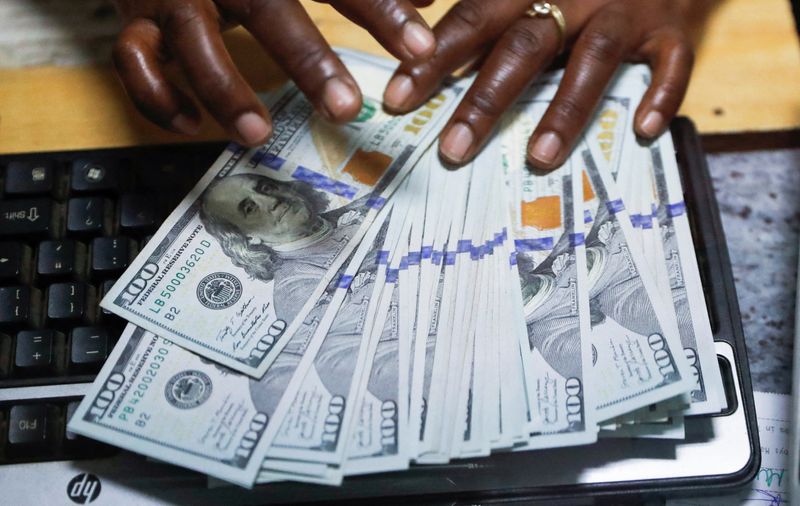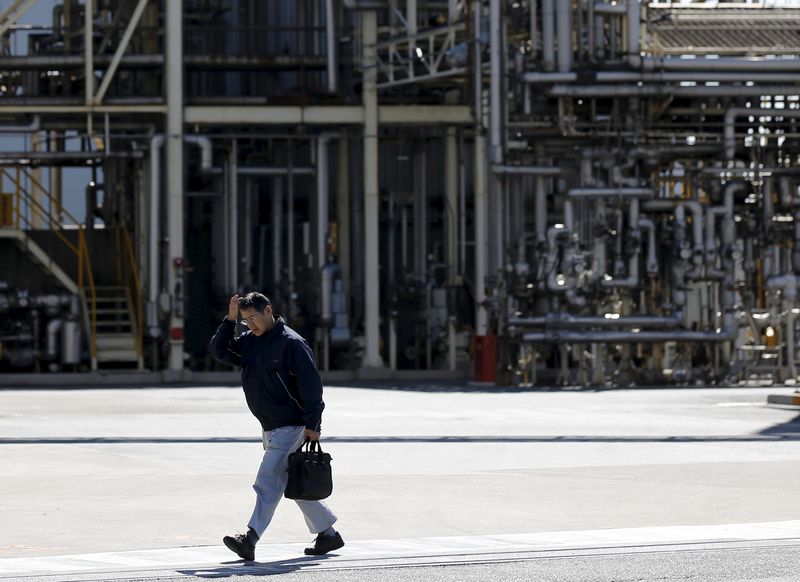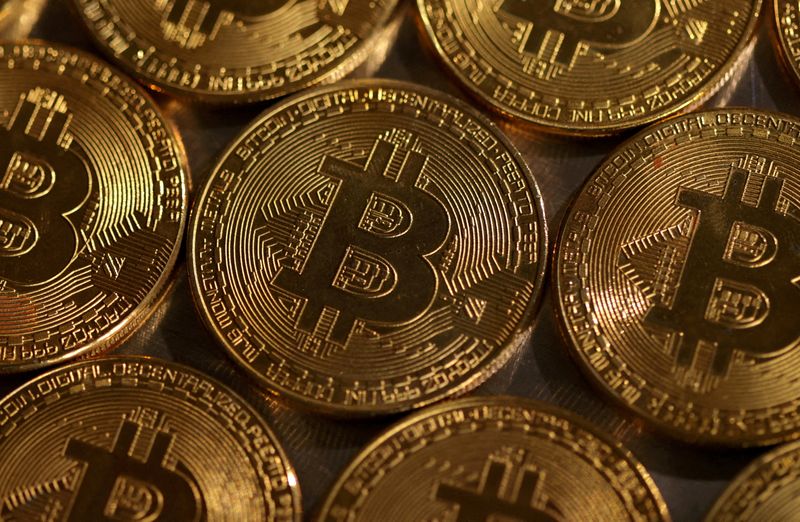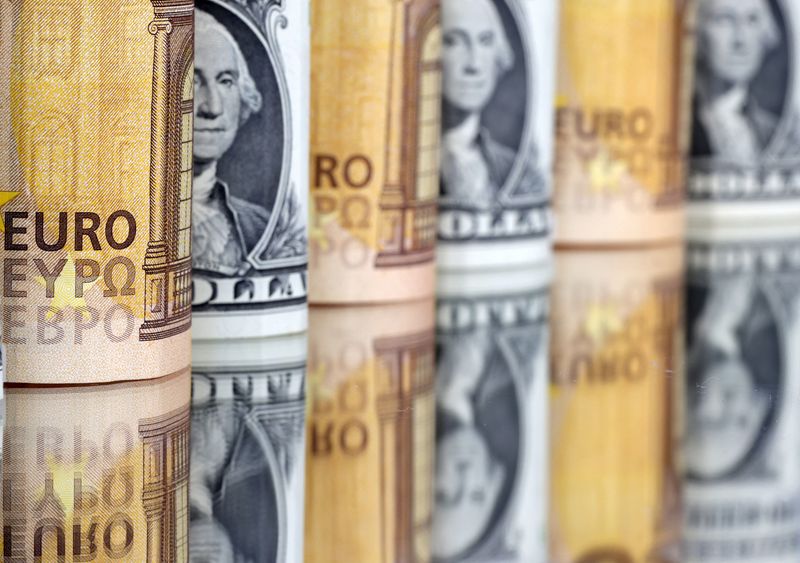Select Language

By Wayne Cole
SYDNEY (Reuters) -Asian shares firmed on Monday as Chinese data surprised on the upside for once, while investors looked to navigate a minefield of central bank meetings this week that could see the end of free money in Japan and a slower glide path for U.S. rate cuts.
Beijing reported industrial output climbed an annual 7% over January and February, while retail sales rose 5.5% on a year earlier. But real estate remained a worry as property investmentfell 9% on the year, underlining the case for further policy support.
Central banks in the United States, Japan, UK, Switzerland, Norway, Australia, Indonesia, Taiwan, Turkey, Brazil and Mexico all meet this week and, while many are expected to hold steady, there is plenty of scope for surprises.
Tuesday could see the end of an era as the Bank of Japan is widely tipped to end eight years of negative interest rates and cease or amend its yield curve control policy.
The Nikkei newspaper on Saturday became just the latest media outlet to flag the move, after major companies granted the biggest pay hikes in 33 years.
There is a chance the BOJ might wait for its April meeting given it will be issuing updated economic forecasts then.
"Whether or not it is March or April, we suspect the language accompanying any such move will carry a cautious tone, emphasising it more as a monetary policy adjustment rather than a tightening at this stage," said Carl Ang, a fixed income analyst at MFS Investment Management.
"For Japan a measured and gradual path of policy normalisation appears appropriate for an economy unaccustomed to higher rates and thus the policy messaging will be critical."
Markets also assume the BOJ will hike at a snail's pace and have a rate of 0.27% priced in by December, compared with the current -0.1%.
The central bank on Monday said it would conduct an unscheduled operation to buy bonds, presumably to head off any significant rise in yields and avoid market volatility.
That might be one reason the yen actually lost ground last week, with the dollar up at 149.10 yen. The euro stood at $1.0887, having eased 0.5% last week and away from a top of $1.0963.
Japan's Nikkei bounced more than 2%, having shed 2.4% last week as a run up to record highs drew some profit taking.
MSCI's broadest index of Asia-Pacific shares outside Japan gained 0.3%, after dipping 0.7% last week. Chinese blue chips firmed 0.6%.
EUROSTOXX 50 futures and FTSE futures both edged up 0.16% and 0.1%, respectively. S&P 500 futures added 0.3% and Nasdaq futures 0.54%, with tension building ahead of the Federal Reserve policy meeting in Tuesday and Wednesday.
COUNTING THE DOTS
The Fed is considered certain to keep rates at 5.25-5.5%, but there is a possibility it might signal a higher for longer outlook on policy given the stickiness of inflation at both a consumer and producer level.
"We now expect 3 cuts in 2024, vs 4 previously, mainly because of the slightly higher inflation path," said Goldman Sachs economist Jan Hatzius in a note.
He still expects the Fed will start in June, assuming inflation eases again as expected, and officials will stick with their dot plot forecasts of three cuts this year.
"The main risk is that FOMC participants might instead be more concerned about the recent inflation data and less convinced that inflation will resume its earlier soft trend," Hatzius cautioned. "In that case, they might bump up their 2024 core PCE inflation forecast to 2.5% and show a 2-cut median."
The Fed is also expected to begin formal discussion of slowing the pace of its bond sales this week, perhaps halving it to $30 billion a month.
Bonds could do with the support given the damage done by a run of uncomfortably high inflation readings. Two-year Treasury yields are up at 4.72%, having climbed 24 basis points last week, while 10-year yields stood at 4.305%. [US/]
The probability of a rate cut as early as June has dropped to 56%, from 75% a week earlier, and the market has only 72 basis points of easing priced in for 2024 compared to more than 140 basis points a month ago.
The Bank of England meets on Thursday and is expected to keep rates at 5.25% as wage growth cools, while markets see some chance the Swiss National Bank might ease this week.
The ascent in the dollar and yields took some shine off gold, which eased to $2,146.70 an ounce, having fallen 1% last week and away from all-time highs. [GOL/]
Oil prices have had a better run after the International Energy Agency raised its view on 2024 oil demand, while the supply outlook was clouded by Ukrainian strikes on Russian oil refineries. [O/R]
Brent added 35 cents to $85.69 a barrel, while U.S. crude rose 36 cents to $81.40 per barrel. [O/R]

By Tetsushi Kajimoto
TOKYO (Reuters -Japan's biggest companies agreed to raise wages by 5.28% for 2024, the heftiest pay hikes in 33 years, the country's largest union group said on Friday, reinforcing views that the county's central bank will soon shift away from a decade-long stimulus programme.
The much-stronger-than-expected increase comes as the Bank of Japan looks close to ending eight years of negative interest rate policy. BOJ officials have stressed the timing of a pivot would depend on the outcome of this year's annual wage negotiations.
Policymakers hope that big pay rises will boost household spending and produce more durable growth in the broader economy, which narrowly avoided slipping into recession late last year.
Workers at major firms had asked for annual increases of 5.85%, topping the 5% mark for the first time in 30 years, according to trade union group Rengo.
"We estimate that this year's wage hikes could reach 5.3%. If that is realised, real wages would turn positive in April-June 2024," said Moe Nakahama, an economist at Itochu Economic Research Institute.
Rengo, which represents about 7 million workers, many at large companies, had set its eyes on hikes of more than 3% in base pay -- a key barometer of wage strength as it provides the basis for bonuses, severance and pensions.
Analysts had expected a rise of more than 4%, after last year's 3.6%, itself a three-decade high.
Rengo chief Tomoko Yoshino told a press conference that rising income inequality, inflation and a labour crunch were among the factors behind the big increase, adding part-time workers would see pay hikes of 6% this fiscal year.
Yoshino said the country was at a critical stage in a shift towards economic revival.
The government is counting on such wage hikes to trickle down to smaller and medium-sized firms, which account for a whopping 99.7% of all enterprises and about 70% of the country's workforce, but many lack the pricing power to pass higher costs on to their customers.
Wage talks for most smaller companies are expected to conclude by the end of March, and any increments are likely to come in lower than those agreed by major firms.
Among smaller delivery companies, for example, only 57% are planning any wage hikes in the fiscal year from April, according to a Japan Chamber of Commerce survey published last month.
Even though Japanese companies have been raising pay, the increases have largely failed to keep up with inflation. Real wages, which are adjusted for inflation, have now fallen for 22 straight months.
LABOUR SHORTAGES
At the labour negotiations, one strong showing emerged after another, led by Toyota Motor (NYSE:TM), the bellwether of annual talks, which unveiled its biggest pay increase in 25 years.
The bumper wage hikes are likely to boost expectations the central bank will end negative interest rates as early as its next policy setting meeting on March 18-19.
Japanese businesses are facing a chronic labour shortage due to an ageing and dwindling pool of workers.
Prime Minister Fumio Kishida is pushing companies to raise wages to help Japan shake off years of deflation and put an end to meagre wage growth that has kept well behind the average for the OECD grouping of rich countries.
The annual pay negotiations - called "shunto" or "spring labour offensive" - are one of the defining features of Japanese business, where relations between labour and management tend to be more collaborative than in some other countries.

BEIJING (Reuters) -China's factory output and retail sales beat expectations in the January-February period, marking a solid start for 2024 and offering some relief to policymakers even as weakness in the property sector remains a drag on the economy and confidence.
Industrial output rose 7.0% in the first two months of the year, data released by the National Bureau of Statistics (NBS) showed on Monday, above expectations for a 5.0% increase in a Reuters poll of analysts and faster than the 6.8% growth seen in December. It also marked the quickest growth in almost two years.
Retail sales, a gauge of consumption, rose 5.5%, slowing from a 7.4% increase in December. Analysts had expected retail sales to grow 5.2%.
The eight-day Lunar New Year holiday in February saw a solid return of travel, which supported revenue of tourism and hospitality sectors.
"China’s activity data broadly stabilised at the start of the year. But there are still reasons to think some of the strength could be one-off," Louise Loo, China economist at Oxford Economics.
"Consumers were buoyed temporarily by festivities-related spending at this start of the year. In the absence of decisive consumption-related stimulus this year, we think it would be difficult to sustain a robust consumer spending pace this year."
Fixed asset investment expanded 4.2% in the first two months of 2024 from the same period a year earlier, versus expectations for a 3.2% rise. It grew 3.0% in the whole of 2023.
Notably, private investment grew 0.4% in the first two months, reversing the decline of 0.4% in the whole year of 2023.
Together with better-than-expected trade data and consumer inflation, Monday's indicators will provide some temporary encouragement for policymakers as they try to shore up growth in the world's second-largest economy to keep it on track for an expansion of around 5% this year.
PROPERTY PAINS
But analysts say achieving such growth would be more challenging than last year, which had a lower base effect due to COVID curbs in 2022. Moreover, the property sector remains weak and could continue to be a major impediment to a solid recovery this year.
Zhiwei Zhang, chief economist at Pinpoint Asset Management, said the economic outlook in the second quarter remains uncertain, noting that property sales "plummeted" while the unemployment rate rose.
Property investment slid 9.0% year-on-year in January-February, compared with a 24.0% fall in December but still far from levels of reaching stability.
The frailty of the sector was highlighted by the poor sales. Property sales by floor area logged a 20.5% slide in January-February from a year earlier, compared with a 23.0% fall in December last year.
The job market worsened with the nationwide survey-based jobless rate at 5.3% in January-February, up from 5.1% in December.
The NBS publishes combined January and February industrial output and retail sales data to smooth out distortions caused by the shifting timing of the Lunar New Year. Activity picked up in the first two months of 2023 as COVID curbs were lifted, which may create a less flattering base effect for this year's data.
Premier Li Qiang promised at the annual parliamentary meeting earlier this month to transform the country's growth model and defuse risks in the property sector and local government debt.
China plans to issue 1 trillion yuan in special ultra-long term treasury bonds to support some key sectors and set a higher quota for local government special bond issuance this year.
The country's central bank governor Pan Gongsheng also said at a press conference on March 6 that there was still room to cut banks' reserve ratio requirement (RRR), following a 50-basis points cut announced in January, which was the biggest in two years.
Global monetary easing expectations may also offer some relief for China's hopes of strengthening its vast manufacturing sector although economic conditions in many key developed nations look gloomy over the near term. Britain slipped into a recession in the second half of last year, while Japan and the euro zone have shown meager growth.
Policymakers have pledged to roll out further measures to help stabilise growth after the steps implemented since June had only a modest effect, but analysts caution Beijing's fiscal capacity is now very limited and note Li's address to the annual parliamentary meeting failed to inspire investor confidence.
Many economists say there is a risk that China may begin flirting with Japan-style stagnation later this decade unless authorities take steps to reorient the economy towards household consumption and market-allocation of resources.

By Jamie McGeever
(Reuters) - A look at the day ahead in Asian markets.
A batch of top-tier Chinese economic data releases gets Asian markets underway on Monday, with sentiment pretty fragile after last week's global market wobble and as investors brace for U.S. and Japanese policy decisions later in the week.
Asian equity markets are on the defensive. The MSCI Asia ex-Japan index's 1.4% slump on Friday - its steepest since January - sealed its biggest weekly loss in two months, while Japan's Nikkei 225 lost 2.5% for its biggest weekly loss this year.
The sharp rebound in U.S. bond yields is taking its toll on risk appetite, and was probably the main catalyst for the selloff in global stocks last week.
The ICE BofA U.S. Treasuries index fell every day last week, its worst run since August resulting in the biggest weekly fall since October. The two-year yield rose 24 basis points, almost the equivalent of a quarter-point rate hike.
The Asia and Pacific calendar this week is packed with hugely important economic data releases and central bank policy meetings, none more so than the Bank of Japan's two-day meeting that starts on Monday.
Expectations are high that the BOJ will raise interest rates for the first time since 2007, bringing the curtain down on eight years of 'negative interest rate policy', or NIRP.
Japan's biggest companies agreed to raise wages by 5.28% for 2024, the heftiest pay hikes in 33 years, the country's largest union group said on Friday, reinforcing views that policymakers will make their historic move on Tuesday.
Sources have also told Reuters that the BOJ will offer guidance on how much government bonds it will buy upon ending NIRP and yield curve control (YCC), to avoid causing market disruptions.
Policy decisions from the central banks of China, Australia, Indonesia and Taiwan are also on tap this week, as are inflation figures from Japan and New Zealand's fourth-quarter GDP report.
The week kicks off on Monday, though, with four key indicators from China - business investment, retail sales, industrial production and unemployment.
Some green shoots of recovery in China are gradually becoming visible. There are signs that capital is no longer flooding out the country, stocks have recovered, and some economic data is improving - China's economic surprises index is the highest since October.
But the road to recovery will be long and rocky. Figures last week showed that house prices fell at their fastest annual rate in over a year, and new bank lending growth fell to the lowest on record.
Figures on Monday are expected to show that business investment growth in February ticked up to 3.2%, industrial output growth slowed to 5.0% and retail sales also slowed to 5.2% from the month before. These are all year-on-year measures.
Here are key developments that could provide more direction to markets on Monday:
- China 'data dump' (February)
- Japan machinery orders (January)
- Malaysia trade (February)
(By Jamie McGeever; Editing by Aurora Ellis)

Investing.com -- Central bank decisions will be front and center in what’s set to be an action-packed week as investors attempt to gauge how close the Federal Reserve is to cutting rates. The Bank of Japan appears to be shaping up to exit negative interest rates after months of anticipation. Meanwhile, AI darling Nvidia (NASDAQ:NVDA) is to hold a closely watched developer conference. Here’s what you need to know to start your week.
Federal Reserve meeting
Last week’s hotter-than-expected U.S. producer and consumer price data prompted traders to rein in bets on future cuts from the Fed.
All eyes are now on Wednesday’s Fed meeting and any clues on the central bank's outlook for rate cuts, the resilience of the U.S. economy and the possibility of an inflationary rebound.
Earlier this month Fed Chair Jerome Powell said officials have “gained greater confidence that inflation is moving sustainably” toward the central bank’s 2% goal but added that they want more evidence that inflation is slowing before they begin easing.
“We think that the Fed is still likely to ease at mid-year (June or July), but the FOMC meeting will keep us squarely in the wait-and-see period by another one or two meeting cycles, with Jay Powell repeating that he needs a “little bit more” evidence that disinflation is sustainable before he would cut the Fed Funds rate target” analysts at Macquarie said in a note.
BOJ
Tuesday’s BOJ meeting could be one of the most consequential in years with officials set to decide whether to end eight years of negative interest rates in what would mark a landmark shift away from its huge stimulus program.
Japan’s Nikkei newspaper reported Saturday that the BOJ is expected to end its negative interest rate policy this week after the countries biggest companies agreed with labour unions to raise wages by the largest amount in 33 years in annual wage negotiations.
The BOJ began coordinating both within and outside the bank Friday on ending its negative interest rate policy, the report said.
With an end to negative rates seen as nearly a done deal, the market's attention is shifting to any clues the BOJ could give on the pace of any interest rate hikes thereafter.
Bank of England
The BoE will likely play for time in Thursday's rate announcement as it awaits greater clarity on wage growth, which remains stronger than in the U.S. or the euro zone.
Markets are currently expecting the BoE to start cutting borrowing costs from 5.25% - the highest since 2008 - in August, after both the Fed and the European Central Bank.
Investors will be on the lookout for any change in language about putting the BoE's Bank Rate "under review" and any shift in the balance of votes after February's three-ways split. And Wednesday's inflation reading could cause a last-minute rethink.
Nvidia developer conference
The Nvidia GTC developer conference due to get underway on Monday will be watched closely for AI-related announcements with investors undoubtedly keen to hear announcements that will sustain the mammoth rally in its stock.
CEO Jensen Huang will deliver the keynote address and may offer attendees a first look at its newest products, including its next generation B100 GPU for AI and high-performance computing applications.
Nvidia’s gains for the year to date have already added $1 trillion to the company’s market valuation, catapulting it into a position as the top-performing stock in the S&P 500 Index, but the stock has seen some volatility since a record high close on March 7.
Oil prices
Oil prices dipped on Friday, a day after topping $85 a barrel for the first time since November, but prices finished more than 3% higher for the week on rising demand from U.S. refiners completing planned overhauls.
In the coming week energy traders will be looking to Wednesday’s Fed meeting as cuts in interest rates are seen as opportunity for demand growth in the United States.
Oil prices were boosted after the International Energy Agency on Thursday raised its view on 2024 oil demand for a fourth time since November as Houthi attacks have disrupted Red Sea shipping.
The gains came despite the U.S. dollar strengthening at its fastest pace in eight weeks. A stronger dollar makes crude more expensive for users of other currencies.
--Reuters contributed to this report

SINGAPORE (Reuters) - Bitcoin eased to a one-week low in volatile trade on Friday, as investors took profit from its run to a record high and as another upside surprise on U.S. inflation dimmed prospects of early rate cuts there and dented demand for riskier assets.
Bitcoin fell more than 5% in the Asian session to bottom at $66,629.96, before paring some of its losses to last trade 3.5% lower.
The choppy moves in the world's largest cryptocurrency came a day after its charge to a high of $73,803.25, setting a new record for a fourth straight day.
"Bitcoin has an established history of getting volatile and ruthless after hitting (a) record high," said Matt Simpson, senior market analyst at City Index.
"And not only did it recently hit a new high, but it looks like the (Federal Reserve) won't be as dovish as traders had hoped."
A slew of data out on Thursday showed that while U.S. retail sales rebounded less than expected in February, producer prices increased more than expected.
The releases came on the heels of U.S. consumer price data out earlier in the week that pointed to still-sticky inflationary pressures.
Markets reacted by paring the chances of a Fed easing cycle beginning in June, with futures now pointing to a roughly 60% chance of a rate cut that month, down from roughly 74% a week ago, according to the CME FedWatch tool.
A higher-for-longer rates scenario, particularly in the United States, is typically bad for risk-sensitive assets such as crypto.
Still, bitcoin remains nearly 60% higher for the year to date, helped by a crypto frenzy driven by flows into U.S. spot exchange-traded crypto products and as traders remain broadly focused on the prospect of global interest rates being lower by the year-end.
In a show of optimism over bitcoin's bull run, software firm MicroStrategy said it is planning to raise capital through a convertible bond offering to buy bitcoin for the second time in less than 10 days.
The company had on March 5 announced a $600 million private offering in convertible notes, as it looks to increase its exposure to the booming digital asset.
Some experts say the news also contributed to bitcoin's volatile moves on Friday.
"Unlike traditional stock markets, the crypto market lacks regulations that limit the impact of influential individuals or entities with concentrated holdings," said Joshua Chu, chief risk officer at Invess, an AI-enabled algo risk management financial engineering company.
"This absence allows whales to make substantial trades that can trigger cascading effects and rapid price fluctuations, leading to heightened volatility."
Elsewhere, ether, the second-largest cryptocurrency, similarly touched a one-week low, and was last down more than 4% to $3,670.

By Leika Kihara
TOKYO (Reuters) - The Bank of Japan is close to ending eight years of negative interest rate policy, with expected historical wage hikes heightening the prospect of a landmark shift away from its massive stimulus programme next week.
Internal preparations for an exit have been in the works since Kazuo Ueda took office as BOJ governor in April last year, and were mostly done by year-end, say sources familiar with the bank's thinking.
BOJ officials, including Ueda, have recently stressed the timing of a shift away from negative rates would depend on the outcome of this year's annual wage negotiations between workers and employers.
The bumper pay hikes offered by big firms like Toyota Motor (NYSE:TM) this month, the biggest in 25 years, are now seen clearing the way for the BOJ to phase out its massive stimulus.
If the board believes the conditions are right, the BOJ will set the overnight call rate as its new target and guide it in a range of 0-0.1% by paying 0.1% interest to excess reserves financial institutions park with the central bank.
The BOJ will likely make a final decision on whether to pull the trigger next week, or hold off until April, after scrutinising a preliminary survey of big firms' wage talk outcome to be released by labour umbrella Rengo later on Friday.
"If big firms are offering big pay hikes, it's highly likely that smaller firms will follow suit to some extent so they can hire enough staff," said Yoshiki Shinke, senior executive economist at Dai-ichi Life Research Institute.
"Rengo's survey due out on Friday will give the BOJ a big reason to end negative rates in March," he said.
Analysts expect Friday's Rengo survey to show wage increase of around 4.5% or even 5%, far above the 3.8% hike in a poll conducted a year ago, heightening hopes that rising pay will revive stagnant household spending and broader economic growth.
Upon exiting its negative rate policy, the BOJ will also ditch its bond yield control and discontinue purchases of risky assets such as exchange-traded funds (ETF), sources have told Reuters, putting a formal end to the radical monetary experiment of former Governor Haruhiko Kuroda in place since 2013.
A poll taken in March showed 35% of economists expect the BOJ to end negative rates at the two-day meeting ending on Tuesday, up from the previous month's 7% but still below 62% projecting such action at a subsequent meeting on April 25-26.
With an end to negative rates seen as nearly a done deal, the market's attention is shifting to any clues the BOJ could give on the pace of any interest rate hikes thereafter.
Ueda has said the central bank will maintain accommodative monetary conditions even after ending negative rates, and avoid causing any "discontinuity" from the current ultra-loose policy given uncertainty over the economic outlook.
Any guidance on the future policy path that the BOJ could offer upon ending negative rates will likely be in line with such comments, sources have told Reuters.
Under previous governor Kuroda, the BOJ deployed a huge asset-buying programme in 2013 to reflate growth and fire up inflation to its 2% inflation in roughly two years.
The central bank introduced negative rates and yield curve control (YCC) in 2016 as tepid inflation forced it to tweak its stimulus programme to a more sustainable one.
However, last year, as the yen's sharp falls pushed up the cost of imports and heightened public criticism over the cost of Japan's ultra-low interest rates, the BOJ tweaked YCC to relax its grip on long-term rates.
An end to negative short-term rates would be Japan's first interest rate hike since 2007.

By Alasdair Pal
SYDNEY (Reuters) - New Zealand will report "significantly slower" economic growth for the next few years when it releases a pre-Budget update in two weeks' time, Finance Minister Nicola Willis said on Friday, as slower productivity growth hampers the country's economy.
New Zealand's economy unexpectedly contracted in the third quarter and significant downward revisions were made to economic growth in earlier quarters, leading the market to pull back on bets of further interest rate hikes next year.
That, combined with recent data continuing to be weaker than forecast, has led Treasury officials to reassess growth projections for the economy, Willis said.
"The numbers haven’t been finalised, but I know enough to say they won’t make happy reading," Willis said, according to a copy of a speech to business leaders in Auckland on Friday.
"Treasury is now warning me that growth over the next few years is likely to be significantly slower than it had previously thought."
In December, New Zealand's Treasury forecast real annual GDP growth of 1.5% for the fiscal years ending June 2024 and 2025.
The weaker growth projections would not lead to cuts to government investment, Willis said.
Instead, the government plans to promote growth in several sectors, including space and biomedical engineering, alongside the country's traditional strengths of farming, fishing and tourism.
"With low-growth forecasts bearing down on New Zealand, now, more than ever, we must double-down on the drive for real economic growth," she said.
New Zealand will publish a Budget Policy Statement in two weeks' time, ahead of a Budget due on May 30.

By Gertrude Chavez-Dreyfuss
NEW YORK (Reuters) -The U.S. dollar advanced on Thursday, boosted by data showing hotter-than-expected producer prices last month and fewer people seeking unemployment claims, which suggested that the Federal Reserve could reduce the number of rate cuts this year.
The dollar index, which gauges the currency against six major peers, rose in three of the last four sessions. It was last up 0.6% at 103.36. For the week, the index was up 0.6%, on pace for its largest weekly gain since mid-January.
Data on Thursday showed the U.S. producer price index for final demand rose 0.6% in February after advancing by an unrevised 0.3% in January. Economists had forecast the PPI climbing 0.3%.
In the 12 months through February, the PPI surged 1.6% after advancing 1.0% in January. The report followed data on Tuesday that consumer prices increased strongly for a second straight month in February.
A separate report from the Labor Department was also better than expected, showing that U.S. initial claims for state unemployment benefits fell 1,000 to a seasonally adjusted 209,000 for the week ended March 9. Economists had forecast 218,000 claims in the latest week.
"The price action proves the point that people were not positioned for how strong everything (U.S. data) was this morning," said Erik Bregar, director of FX and precious metals risk management, at Silver Gold Bull in Toronto.
"The thinking now is that: what could the Fed say dovishly next week? If anything, they could be on the hawkish side."
The Fed's current dot plot, or the central bank's interest rate forecast, showed three rate cuts for 2024, although that was released back in December. U.S. inflation numbers since then have been sticky, while the labor market remained tight.
The U.S. central bank's policy meeting is set to run from March 19-20 and while the market is not expecting any change in interest rates, investors will be closely watching for revisions to the dot plot.
U.S. rate futures have pared back the chances of a rate cut at the June meeting to 60%, from about 67% late on Wednesday, according to LSEG's rate probability app. For 2024, the market is now pricing in less than three rate cuts, down from between three to four roughly two weeks ago.
Another piece of data on Thursday showed some deceleration in spending. U.S. retail sales rose 0.6% last month and the numbers for January were revised lower to show sales tumbling 1.1% instead of 0.8% as previously reported.
Economists polled by Reuters had forecast retail sales in February, which are mostly goods and are not adjusted for inflation, rising 0.8%.
The retail sales report, however, has not dented the market's growing conviction that the Fed's rate-cutting cycle will be gradual.
Elsewhere, the Bank of Japan started to make arrangements to end its negative interest rate policy at the March 18-19 meeting, Jiji news agency reported. The yen firmed against both the dollar and euro after the report but it has since weakened versus the greenback.
Preliminary results of Japan's spring wage negotiations are due on Friday, with several of the country's biggest companies having already agreed to meet union demands for pay increases.
The dollar was last up 0.4% versus the yen at 148.29 yen, while the euro stayed lower against the Japanese unit, down 0.3% at 161.35.
In other currencies, the euro dropped 0.6% to $1.0884. There was no major European economic data on Thursday.
Sterling fell as well versus the dollar, sliding 0.4% to $1.2745.
In cryptocurrencies, bitcoin fell more than 5% after earlier hitting a record $73,803. It was last at $69,381. Exchange-traded bitcoin funds and optimism that the Fed will cut interest rates this year have boosted the biggest cryptocurrency to repeated record peaks.

WASHINGTON (Reuters) - U.S. producer prices increased more than expected in February amid a surge in the cost of goods like gasoline and food, which could fan fears that inflation was picking up again.
The producer price index for final demand rose 0.6% last month after advancing by an unrevised 0.3% in January, the Labor Department's Bureau of Labor Statistics said on Thursday. Economists polled by Reuters had forecast the PPI climbing 0.3%.
A 1.2% jump in the prices of goods accounted for nearly two-thirds of the increase in the PPI. Goods prices were driven by energy products, which surged 4.4% after declining 1.1% in January. Goods prices had edged down 0.1% in January.
In the 12 months through February, the PPI shot up 1.6% after advancing 1.0% in January.
Government data on Tuesday showed consumer prices increasing strongly for a second straight month in February. But economists largely shrugged off the rise, arguing that difficulties adjusting the data for price increases at the start of the year continued to exert an upward bias on inflation.
Wholesale gasoline prices rose 6.8% last month. There were also increases in the prices of diesel and jet fuel. But prices for hay, hayseeds, and oilseeds fell as did those for iron and steel scrap and asphalt. Food prices rose 1.0%, amid increases in the costs of eggs and beef.
Excluding food and energy, goods prices rose 0.3%, matching January's gain. This suggests that goods deflation, the major driver of lower inflation, was drawing to an end and services would need to pick up the slack in easing price pressure.
Services gained 0.3% in February after rising 0.5% in the prior month. A 3.8% increase in the costs of hotel and motel rooms accounted for a quarter the increase in services prices.
There were also increases in the costs of outpatient care, airline tickets as well as securities brokerage, dealing and investment advice. Portfolio management fees gained 0.2% after accelerating 5.9% in January.
Portfolio management fees, healthcare, hotel and motel accommodation, and airline fares are among components that go into the calculation of the personal consumption expenditures (PCE) price indexes. The PCE price indexes are the inflation measures tracked by the Federal Reserve for it 2% target.
Financial markets expect the U.S. central bank to start cutting interest rates by June. Since March 2022, the Fed has raised its policy rate by 525 basis points to the current 5.25%-5.50% range.
The narrower measure of PPI, which strips out food, energy and trade services components, rose 0.4% in February after climbing 0.6% in January. The core PPI increased 2.8% year-on-year after gaining 2.7% in January.

